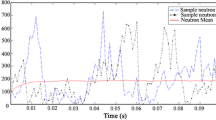Abstract
To describe the reactor kinetics, the number of neutrons and the number of delayed neutron precursors that change with time are considered. The following ordinary differential equations can be gotten if the space dependence of these variables is ignored and the neutron energy is handled in one group. This is called the point reactor kinetics model. Actually, the reactor is not treated as a single point but the assumption is made that the space distribution of parameters does not change with time. When a slow disturbance is treated in spatial asymmetry, the point reactor kinetics model can be used by weighting the reactivity feedback amount determined with the importance function. Generally, the point reactor approximation can be used to approximate a slow change of the space distribution of parameters. It can be applied to many transient events that contain the disturbance to be handled by reactor control. In contrast, when handling a local and fast (that is, approximately 0.1 s or less) reactivity disturbance, the space-dependent kinetics model must be used. An example is the accident that may occur if asymmetric control rods are quickly withdrawn.
An erratum to this chapter can be found at http://dx.doi.org/10.1007/978-4-431-54195-0_12
Access this chapter
Tax calculation will be finalised at checkout
Purchases are for personal use only
Similar content being viewed by others
Author information
Authors and Affiliations
Editor information
Editors and Affiliations
Chapter 2 Exercises
Chapter 2 Exercises
-
1.
Draw a diagram of the power change when 0.1 % positive reactivity is inserted stepwise for 30 s in the critical reactor having steady 1-watt power.
(Question 3-2 from the seventh examination for license of chief reactor engineers of Japan)
-
2.
Prove that the total amount of released energy, E, until time “t” seconds, is expressed approximately by the following equation when large reactivity is inserted stepwise in a critical reactor.
$$ E=[P(t)-P(0)]\frac{l}{{{k_{\mathrm{ eff}}}(\rho -\beta )}} $$-
ℓ is the prompt neutron lifetime.
-
ρ is the reactivity insertion rate (ρ > β).
-
k eff is the effective neutron multiplication factor.
-
β is the delayed neutron fraction.
-
P(t) is the reactor power at time “t” seconds.
-
The structural change of core materials and the reactivity feedbacks are ignored.
(Question 1-5 from 14th examination for license of chief reactor engineers of Japan)
-
-
3.
Obtain the transient behavior of the reactor power with neutron source strength S and neutron lifetime ℓ, for the following three cases, and draw them in a figure. Ignore all reactivity feedbacks such as delayed neutron and temperature coefficient. Treat all energies as one group. Use the point-wise reactor approximation for the solution.
- Case (1):
-
When neutron source strength S is inserted quickly in the subcritical core (the effective multiplication coefficient k eff < 1 and the neutron density n = 0) at time t = 0.
- Case (2):
-
When neutron source strength S is removed quickly from the subcritical core (the effective multiplication coefficient k eff < 1 and the neutron density n = n0) at time t = 0.
- Case (3):
-
When neutron source strength S remains in the core (the neutron density n = n 0) of the critical reactor.
(Question 3-2 of the 17th examination for license of chief reactor engineers of Japan)
-
4.
-
(a)
Prove that the power change is roughly expressed by the following equation when the positive reactivity, δk, is inserted stepwise in the reactor operating at constant power.
$$ \frac{{\mathrm{ d}n}}{{\mathrm{ d}t}}=\frac{{\delta k-\beta }}{{{l^{*}}}}n+\frac{\beta }{{{l^{*}}}}{n_0} $$-
n is the power (in neutron numbers).
-
n 0 is the initial steady power (in neutron numbers).
-
ℓ * is the average effective neutron lifetime.
-
β is the delayed neutron fraction.
-
t is the time.
-
-
(b)
Solve the equation in (a), derive an approximate expression of the power change, and draw a graph.
-
(c)
Determine the gradient of the power change at time zero.
(Question 3-2 from the 17th examination for license of chief reactor engineers of Japan)
-
(a)
-
5.
When the large reactivity is added stepwise to the subcritical reactor with the neutron source strength S and the reactor becomes supercritical (delayed supercritical), neutron density n rapidly increases at first, and then it increases gradually.
The rapidly increasing neutron density δn (>0) is small even for the same δk when (1) the initial value of n is small and (2) when S is large. Prove them using equations.
Note that approximate values can be used for δn and δk as they are small.
(Question 3-2 from the 16th examination for license of chief reactor engineers of Japan)
Rights and permissions
Copyright information
© 2013 Springer Japan
About this chapter
Cite this chapter
Oka, Y. (2013). Point Reactor Kinetics. In: Oka, Y., Suzuki, K. (eds) Nuclear Reactor Kinetics and Plant Control. An Advanced Course in Nuclear Engineering. Springer, Tokyo. https://doi.org/10.1007/978-4-431-54195-0_2
Download citation
DOI: https://doi.org/10.1007/978-4-431-54195-0_2
Published:
Publisher Name: Springer, Tokyo
Print ISBN: 978-4-431-54194-3
Online ISBN: 978-4-431-54195-0
eBook Packages: EnergyEnergy (R0)




